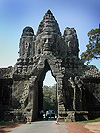|
Angkor Thom (អង្គរធំ)
Khmer. ‘Big
Angkor’. Name of a three square kilometer walled and moated royal
Khmer
city
in
Cambodia, built in the 12th century during the reign of King
Jayavarman VII (fig.), who ruled from probably 1181 to 1219. After King Jayavarman VII recaptured the Angkorian capital from the
Cham invaders in 1181, he began a massive building campaign across his empire, constructing Angkor Thom as his new capital and adding an outer wall and moat. The city has five entrance gates, one for each cardinal point and the Victory Gate which leads to the royal palace area. Each gate is crowned with four giant faces and with statues of the god
Indra and his mount
Erawan on each of the gate's corners. In front of each of the gates, in the approach to the city, are
naga-bridges,
known in Khmer as
Spean
Neak,
that cross the moat and have
balustrades displaying the churning of the
Ocean of Milk by the gods and the
asuras (fig.).
In 1352, the
Ayutthayan
King
U-Thong
laid siege to Angkor Thom and the next year successfully captured the city,
placing one of their princes on the throne, though in 1357 the Khmer regained
control. Then, in the 15th century, Angkor Thom was again raided by the
Ayutthayan King
Borommarachathirat II,
and abandoned. It
was the last capital of the Angkorian Empire and is located to the north of
Angkor Wat. It has the great temple of
Bayon (fig.) at its centre,
while other structures include
Prasat
Vimean Akas
(fig.), the Terrace of the Leper King (map
-
fig.)
and the Terrace of the
Elephants (map
-
fig.).
In Thai, known as
Nakhon Thom. See also
ton lanthom
and MAP.
回






|

